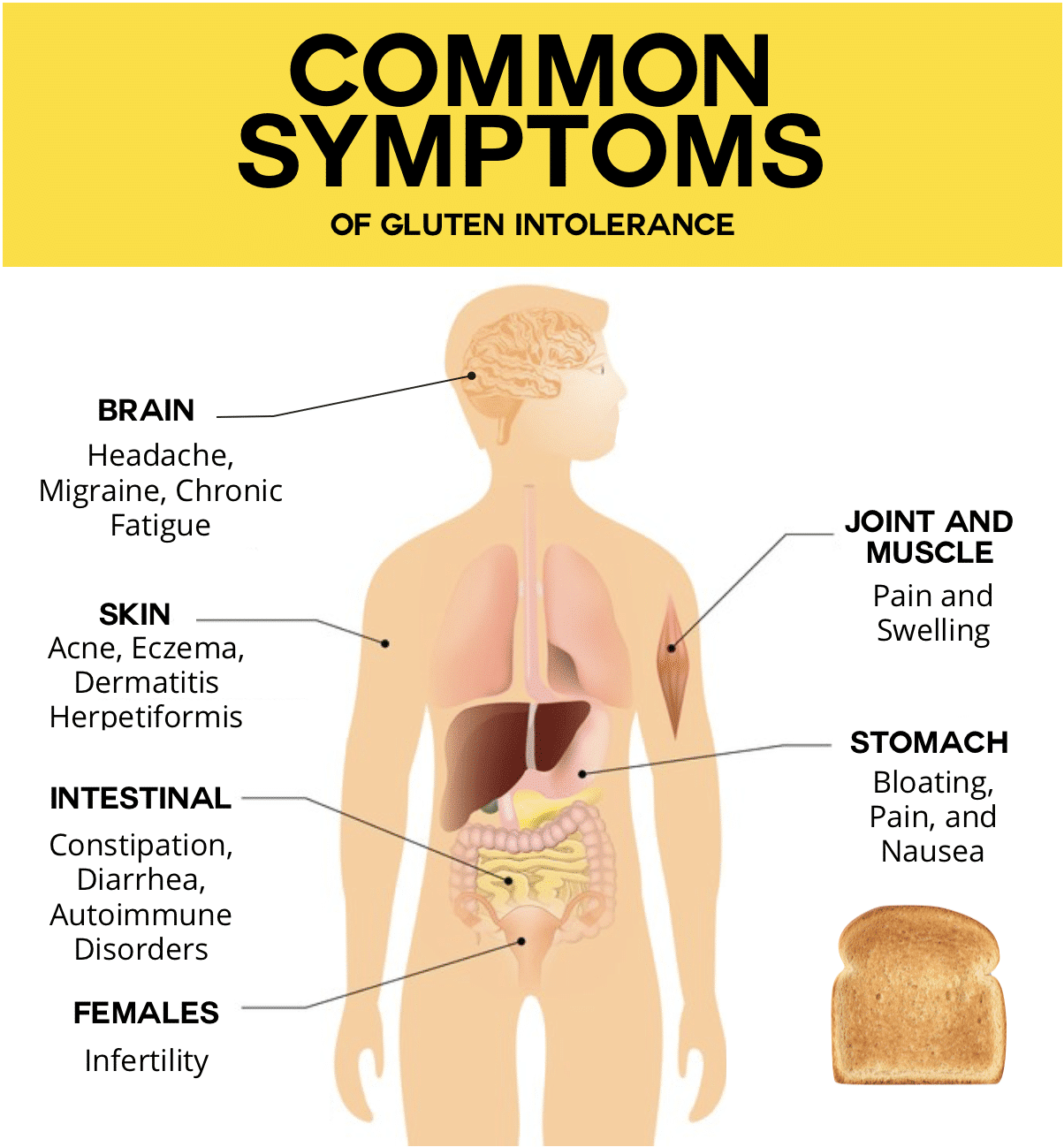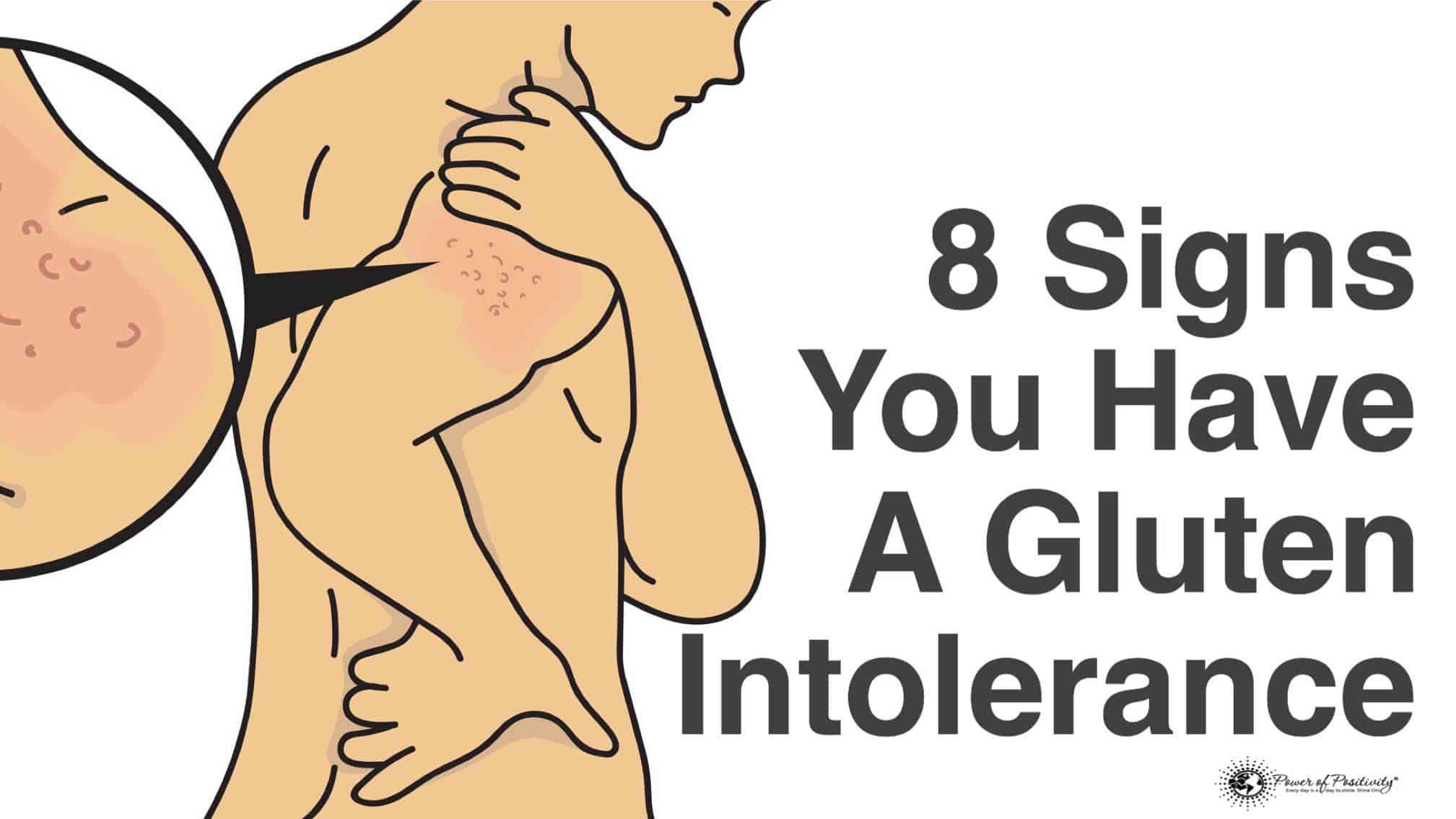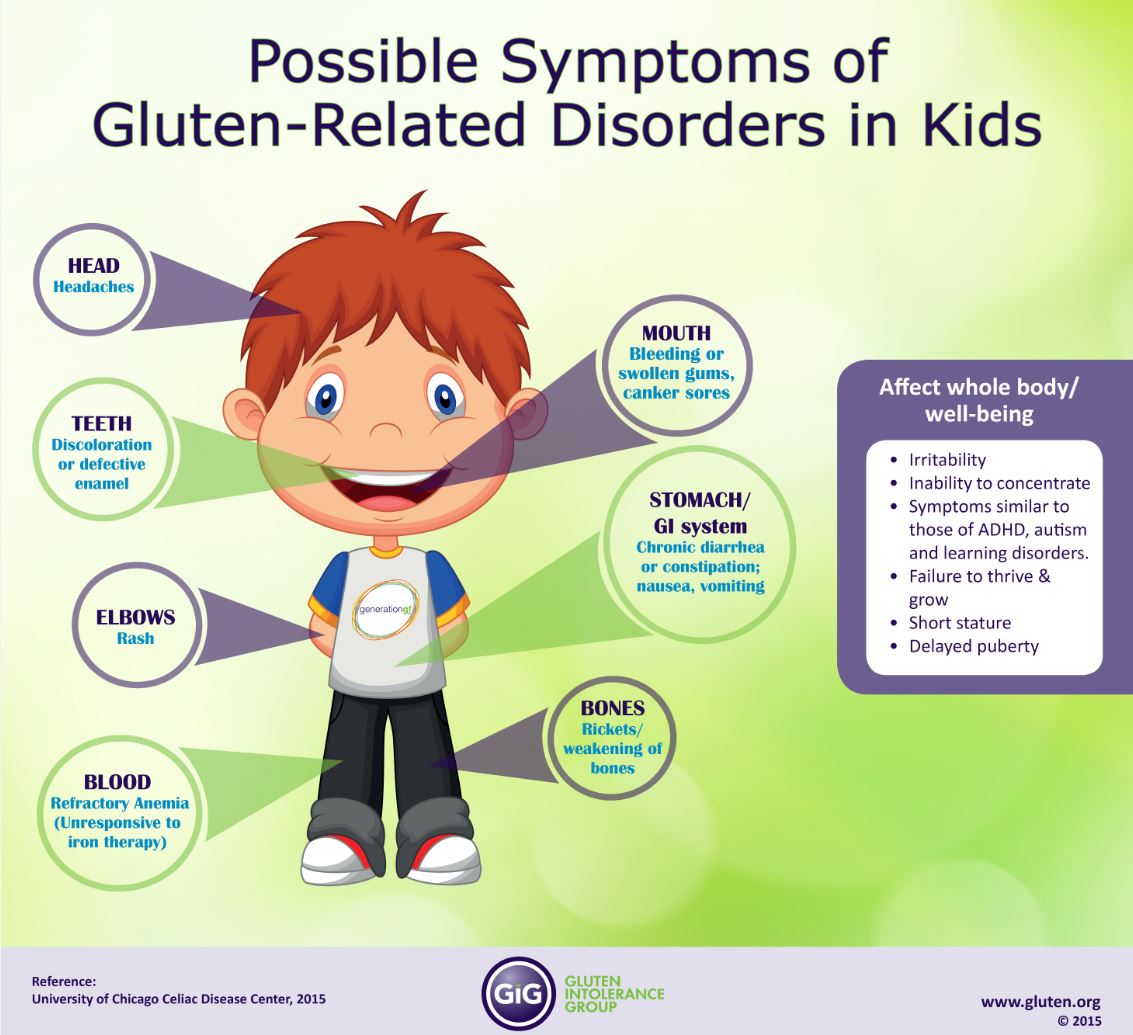Bloating Constipation And Gas
None of these symptoms are easy to deal with in everyday life. They may also become serious if constipation goes on for too long.
Celiac disease causes these digestive and gastrointestinal problems. One way to test for gluten intolerance is to cut out gluten completely and see if there is rapid and substantial improvement in bloating, constipation, and gas.
If these symptoms are lost with the elimination of gluten in the diet, it is a tell tale sign that the gluten is causing the issues.
Getting A Proper Diagnosis Is Key
Getting a proper diagnosis is the first step toward feeling better and living a healthy life. Diagnosing celiac disease is pretty straight forward. A gastroenterologist will be able to make a diagnosis based on blood tests and a biopsy of the small intestine.
Diagnosing non-celiac gluten intolerance is a little trickier. Your physician will test you for celiac disease, wheat allergy and other things that might be associated with your particular symptoms. If you test negatively for those things, youll start a gluten-free diet. If going gluten-free for a while improves your symptoms, youll probably be diagnosed with non-celiac gluten intolerance.
If you think you might have a gluten intolerance, its important to keep gluten in your diet until you visit your physician. This is the only way the to test properly.
The Truth About Gluten Intolerance
Gluten is the glue that holds it all together, and its a protein found in wheat, barley and rye. Meaning its found in foods you probably eat every day bread, pasta, crackers, cereals, salad dressings and more.
So what happens when your body has an intolerance or sensitivity to gluten? The results can be unpleasant, painful and downright dangerous to your long-term health. Heres what you should know about gluten intolerance.
Recommended Reading: Gf Substitute For Bread Crumbs
How Is Ncgs Diagnosed
Gluten intolerance symptoms are similar to those of other medical conditions, so you need to see your doctor for a diagnosis rather than diagnosing yourself.
They will ask you questions about your symptoms and may examine your abdominal area. In order to rule out coeliac disease, they will probably ask you to do a screening blood test.
Removing the main sources of gluten may remove symptoms, but if you have coeliac disease, you will still do damage to your bowel if you eat small amounts of gluten or are exposed to it through cross-contamination of gluten-free food with gluten-containing ingredients.
If a diagnosis of coeliac disease has been excluded, there may still be other causes for your symptoms when you eat gluten. For example, your doctor will want to work out whether your symptoms only occur with wheat-containing foods .
Your doctor will also want to consider whether your symptoms might be caused by irritable bowel syndrome. Once you have an accurate diagnosis, your doctor will be able to provide you with advice as to the most appropriate dietary changes.
You’re Losing Weight Without Trying

Involuntary weight loss is one of the primary symptoms of celiac disease, because when your intestines are damaged you aren’t properly absorbing the food you eat, says Megan Patrick, M.D., a family medicine physician at UCHealth.
While NCGS doesn’t damage a person’s intestines, it can still lead to eating less due to associating so many foods with pain, which in turn can cause weight loss, says De Latour.
Also Check: Is Kraft Zesty Italian Dressing Gluten Free
Joint And Muscle Pain
There are various reasons why individuals experience muscle pain and joint pain. There is a theory that individuals with celiac disease are genetically over-sensitive or have an over-excitable nervous system. Therefore it lowers their threshold to activate sensory neurons, which causes joint and muscle pain.
Exposure to gluten can also cause inflammation in individuals who are gluten sensitive. This inflammation also results in full-body pain, including muscles and joints.
How Is Ncgs Treated
Many people cut gluten from their diet because they think they are intolerant to it. But because it’s hard to know whether the symptoms are due to an intolerance to gluten, an intolerance to something else in wheat, or some other reason, see your doctor for an accurate diagnosis to prevent unnecessary avoidance of gluten. Your doctor can make a referral to a dietitian to help you make decisions about your diet.
Very few people need to cut out gluten from their diet . However, if your doctor thinks this is the best approach for you, a dietitian can teach you how to replace the nutrients you will miss out on with a gluten-free diet. Read more about the gluten-free diet.
Also Check: Gluten Free Pie Crust Publix
Joint Pain And Arthritis
Most gluten intolerance patients experience migratory arthritis whereby joint pain and stiffness affect various bones in the body. Unlike other types of arthritis that generally stay in one position only, here symptoms can heighten periodically at different times and even migrate to other positions in the body. Some doctors may rule out autoimmunity as a possible cause by running tests for lupus, rheumatoid arthritis, and spondyloarthritis instead. These more often than not come back negative.
Other standardized medical tests employed for evaluating inflammation include Erythrocyte Sedimentation Rate . Sometimes physicians also try ruling out viral or bacterial infections such as Lyme disease, which can closely mimic this condition. Some common symptoms of migratory arthritis apart from joint pain are tendon redness and swelling.
Signs You Have A Gluten Intolerance
Gluten sensitivity or intolerance is a condition that causes a person to react after ingesting gluten, a protein found in wheat, barley and rye. Symptoms vary widely and can include gastrointestinal problems, joint pain, fatigue and depression. WebMD
It is quite common for people to experience digestive and health problems from eating wheat or gluten. Found primarily in wheat, barley and rye, gluten intolerance can result in a number of different symptoms.
Wheat is a type of grain that is commonly found in breads, cereals and pasta. Less-common sources include condiments, such as salad dressings and soups. Barley is another abundant variety of grain, which is often used for brewing and stock feed products. Rye is the last type of grain that contains gluten. Rye is most often found in cereals, beer and breads. Consuming these types of foods and beverages is often how one discovers their intolerance to gluten.
Celiac disease is a serious type of gluten intolerance. Classified as an autoimmune disorder, celiac disease causes damage to the small intestine. When those with the disease consume gluten, it initiates an abnormal immune response that directly attacks the intestines. Eventually, damage caused to the intestines significantly lessens the bodys ability to properly absorb nutrients. If not properly treated, celiac disease can result in long-term health complications. It is estimated that 1 in 100 people suffer from the disease.
Read Also: Is Gluten In Wine
Common Signs Of An Issue With Gluten
Chances are, you donât have a silent problem with gluten – if you have an issue, your body will tell you! But those signs might be different for everyone, from GI symptoms like gas and bloating to brain fog and headaches. How can all of these be related to just one type of food? Gluten can affect your entire body, especially if you have celiac disease. But those with other gluten-related disorders like gluten intolerance can also feel its effects.
Finding A Good Doctor For Gluten Issues
If you would like to find a good primary care doctor to consult with about gluten intolerance, then let BASS Medical Group help. Our goal is to ensure that your health is in the right hands and you are happy with your care. Give us a call today at 925-350-4044 so that we can point you to the nearest location or schedule an appointment online.
Read Also: Gluten Free English Muffins Publix
Youre Losing Weight Without Trying
Involuntary weight loss is one of the primary symptoms of celiac disease, because when your intestines are damaged you arenât properly absorbing the food you eat, says Megan Patrick, M.D., a family medicine physician at UCHealth.
While NCGS doesnât damage a personâs intestines, it can still lead to eating less due to associating so many foods with pain, which in turn can cause weight loss, says De Latour.
A Change In Bowel Habits: Diarrhea And Constipation

New diarrhea, constipation, or just an overall change in bowel habits, are common symptoms of celiac disease or gluten intolerance. But a change in consistency of your poop, or frequency of your bathroom habits are a pretty common occurrence for many digestive diseases. These bathroom issues happen with autoimmune diseases like IBD, irritable bowel syndrome, food sensitivities and food allergies, and even food poisoning.
While it may seem strange to look into the toilet bowl after you go to the bathroom, itâs important for your overall health! You should regularly check if your poop is unusual and if anything changes over time.
- Is it runny like water or hard like rabbit pellets?
- Does it occur with pain – and is the pain better after you go to the bathroom?
- Is it like this all the time, or is this a new occurrence?
- Does it happen after you eat something particular? Are you going to the bathroom more often than usual or less often?
If itâs overwhelming to remember, consider keeping a journal of your bathroom habits, along with a food diary. It may be helpful for your gastroenterologist to know!
You May Like: Food For Life Gluten Free English Muffins
Signs You’re Gluten Intolerant
More than 55 diseases have been linked to gluten, the protein found in wheat, rye, and barley. It’s estimated that 99% of the people who have either gluten intolerance or celiac disease are never diagnosed.It is also estimated that as much as 15% of the US population is gluten intolerant. Could you be one of them?
Gluten Intolerance Vs Gluten Allergy
First, lets clear something important up. Gluten intolerance is not the same thing as a gluten allergy. Gluten intolerance is known as celiac disease, which is a type of autoimmune disorder. In a nutshell, celiac disease means your immune system responds poorly to gluten, which is one of the key compounds in bread products containing rye, wheat, or barley.
When someone with celiac disease eats gluten, their immune system destroys small villi, which are microscopic parts of the small intestine that help to absorb nutrients. Therefore, those with celiac disease experience much more severe symptoms compared to people with gluten allergies or gluten sensitivities, whether that sensitivity comes from genetics or some other biological factor.
You May Like: Graham Crackers Walmart Aisle
Whats About Gluten Free Goods And Whats The Best Type Of Wheat To Eat
For those who dont have a genetic disposition to gluten intolerance, the best type of wheat to eat is non GMO wheat. European wheat is non GMO.
The best American wheat is often called heritage wheat and made by artisinal bakers. Its expensive but worth it. And sour dough starters make wheat more digestible. But this is only for people who have already healed completely. Not for those still in the healing process.
As far as gluten free replacements for favorite foods like toast, cereal and pasta, I dont find them particularly healthy. These are highly processed products and should not be part of a healing diet or protocol. Ok as a rare treat, but I prefer grain-free Paleo baked goods as they are much healthier.
Going completely grain free in the beginning stages of healing is important. The only exception is white rice, which seems to work for some people.
If you are dying for cereal heres my favorite Paleo replacement made only with coconut. I have it with homemade cashew milk.
Most Breads Crackers And Wraps
Most breads, crackers, and wraps contain gluten. The only way to know for sure is to read the ingredient list and check to see which grains are used.
If you have a gluten intolerance, avoid the following:
- white bread
- malt vinegar
- ketchup
As an alternative, you can make your own condiments from gluten-free ingredients or purchase ones that are certified gluten-free.
Read Also: Is Kraft Zesty Italian Dressing Gluten Free
Read Also: Red Wine Gluten
Constipation Diarrhea And Gas
These three symptoms are all very common with all types of food issues and intolerance problems. If you suspect a gluten intolerance, pay close attention to these signs and track when they occur. Keep a food journal that documents everything you eat and drink and how you feel during and afterward. It will help to determine if gluten is causing these problems.
Read Also: Where Are Graham Crackers In Walmart
Signs Of Gluten Intolerance Most People Ignore
Approximately 3.1 million people in the U.S. follow a gluten-free diet, even though 72% fall into a category called PWAGs people without celiac disease avoiding gluten. Over the past five years, the number of people on a gluten-free diet has skyrocketed due to marketing campaigns and health concerns. However, the prevalence of gluten intolerance hasnt increased, indicating that a lot of people have followed trends in health without fully understanding how gluten affects the body.
According to a study by the Mayo Clinic, the benefits of a gluten-free diet remain unknown for people who dont have a gluten intolerance. Concerns about nutrition have been raised since many products with gluten also have a lot of iron, calcium, and fiber.
Gluten intolerance does exist, however, and those who have it report feeling much better after eliminating gluten from their diet. An estimated 10% of the population has gluten sensitivity. About 1% has celiac disease, an autoimmune disorder affecting the small intestine, caused by a reaction to gluten.
Recommended Reading: Kraft Gluten Free Dressing
How Is Celiac Disease Treated
Celiac disease is treated by not eating gluten. This can be hard because gluten is in many foods, but a dietitian can help adjust someone’s diet to cut out gluten. It is important not to start a gluten-free diet unless you are truly diagnosed with celiac disease.
Following a gluten-free diet allows the small intestine to heal. But that doesn’t mean the person can start eating gluten again. For someone with celiac disease, gluten will always irritate the intestines and, if this happens, the diarrhea, belly pain, and other problems will return.
If you’re diagnosed with celiac disease, it can be a challenge to learn which foods contain gluten. You may not be able to remember them all, but you can keep a list with you and ask about menu items at restaurants before digging in. Before you know it, you’ll be a pro at knowing which foods are safe and which are not.
What Causes Gluten Intolerance

While an exact answer isnât known, researchers have an idea on what might cause this sensitivity, or what part of wheat is triggering a reaction in those with this sensitivity. Because of this, you might also hear the phrase non-celiac wheat sensitivity – as some researchers believe the wheat and its protein may be an issue, not the gluten itself.
In fact, there are other components of wheat that are likely culprits for this entity, that should be properly called âNon-celiac wheat sensitivityâ.
Amylase Trypsin Inhibitors are specific proteins found in wheat that researchers think might trigger a reaction.
FODMAP . FODMAPs are fermentable sugars found in some specific foods that not being fully degraded during their flow through the digestive system, draw water into the gut, and are fermented by bacteria. For some people, this fermentation causes pain, gas, and bloating. Some researchers have indeed shown that FODMAPs – specifically the fructans and those fermentable sugars found in wheat – might be the cause of GI upset.
Additionally, it must be acknowledged that research has also shown that in many cases, patients who believe to have non-celiac wheat sensitivity when challenged under close scrutiny in double-blind, placebo controlled studies, fail to show reaction to hidden gluten and even may react to the innocuous placebo. Thus, this disorder may also be, in a portion of patients, a functional disorder, now better defined âdisorders of brain-gut interaction.
Read Also: Gluten Free Pizza Crust Publix
